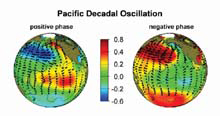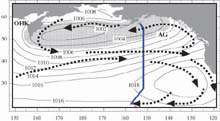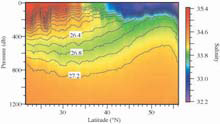
Winter sea surface temperature, wind pattern (arrows), and sea level pressure (contour) anomalies for the warm (left) and cool (right) phase of the Pacific Decadal Oscillation. (Courtesy of Nate Mantua, JISAO Univ. of Washington.) Click image for larger view.
Deep-dwelling Creatures Hold Clues to Climate Change
Thomas P. Guilderson
Department of Ocean Sciences,
Univ. of California, Santa Cruz,
Center for Accelerator Mass Spectrometry, LLNL
Robert B. Dunbar
Stanford University
B. Lynn Ingram
Univ. of California, Berkeley
This expedition includes a research study to increase our understanding of climate and ecosystem variability in the Gulf of Alaska. We will focus on the natural variability of the dominant atmospheric pressure cell (the Aleutian Low) as it relates to the Pacific Decadal Oscillation (a change in climate that occurs approximately every every few decades) and air circulation over the Pacific Ocean. Observational evidence indicates that regional-scale disturbances of the Aleutian Low generate far-field temperature anomalies in the central and eastern North Pacific. The size and intensity of the Aleutian Low, in conjunction with North Pacific sea-surface temperature patterns, initiate prominent and persistent anomalies that have profound consequences on the climate of the Pacific and North America.
These changes in atmospheric circulation can, for example, “reposition” the jet stream, among other things. These anomalies are known to have certain rhthyms, lasting from a year to a decade, with distinct shifts in temperature. We do not know, however, what triggers them, or whether “warmer” or “colder” temperatures will be favored as atmospheric concentrations of carbon dioxide continue to increase.

Time history of the Pacific Decadal Oscillation (solid line) as defined by the leading principle component SST anomalies north of 20° latitude. Click image for larger view.
To study past variations in climate, we will look at the biological, geological, and chemical characteristics of the skeletons of microscopic animals, such as foraminifera, and macrofauna, such as deep-sea corals (Azooxanthellate) and related organisms (e.g., sclerosponges, proteinaceous zooanthids). In general, studies utilizing these organisms have been based on individuals recovered in dredges and hauls. Only recently has there been a more concerted effort to understand the biogeochemistry of these species and their novel applications in reconstructing surface and subsurface conditions.

Generalized schematic of surface circulation (thick dotted lines) and winter (November-March) sea-level pressure (thin solid lines) of the North Pacific. Click image for larger view.
One reason deep-sea corals may be an excellent source of clues to the distant past is that they occur in all the world's oceans, at depths ranging from 0 to 6,200 meters and in water temperatures ranging from 4 to 29 °C. The highest population density of deep-sea corals occurs between 500 and 2,000 m, including a large and diverse distribution along the Alaskan continental margin and the Gulf of Alaska.
A secondary objective of our study is to document the longevity of these deep-sea macrofauna. Gigantia and longevity (“big and old”) is a common biological adaptation in species. Our own research on deep-sea macrofauna, including stony corals and proteinaceous zooanthids, indicates that some individuals live for centuries to millennia -- they are the "old-growth redwoods" of the deep ocean. The fact that these individuals live for such a long time means that we can use them to reconstruct past variations in ocean circulation and surface ocean productivity, in the same fashion that we can reconstruct climate variability from tree rings.

Salinity along 150W in the North Pacific during the Marathon-II expedition (May-June 1984). The subsurface low salinity water mass (green colors) characteristic of NPIW occurs between ~26.6 and 27.0 kg/m3 potential density horizons. Note the low salinity surface waters of the high-latitude North Pacific and the resulting sharp density contrast. It is this sharp density contrast which inhibits direct ventilation of interior waters in the Gulf of Alaska. Click image for larger view.
These large, deep-sea fauna have even more in common with old-growth redwoods: They provide habitat for what would otherwise be a much less diverse group of deep-ocean organisms (biota). Deep-sea corals take a long time to grow large, and are threatened by indiscriminate human activities such as trawling and dredging. We wonder, what will happen to these organisms and the deep-sea ecosystems they support as people grapple with "greenhouse warming" and if they do not strive to reduce carbon-dioxide emissions the world over?
Sign up for the Ocean Explorer E-mail Update List.


























